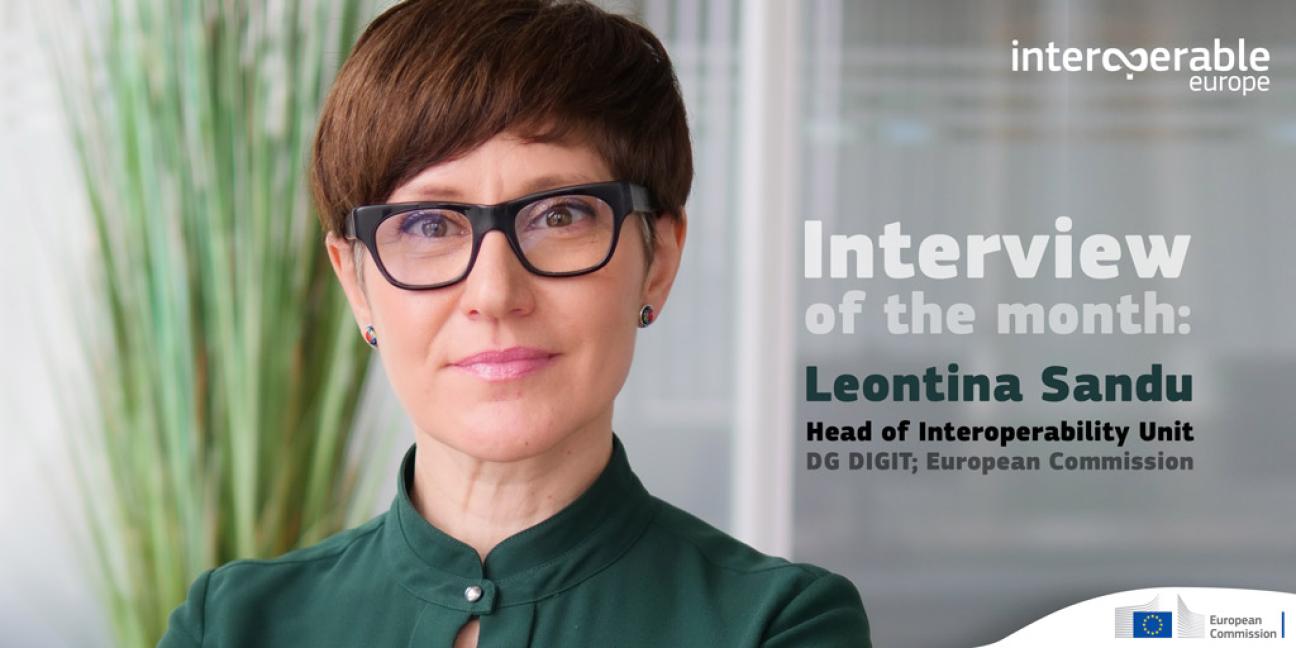Leontina Sandu: “The Interoperable Europe Act empowers Member States to co-own the policy making process”
more news
Leontina Sandu is the Head of the Interoperability Unit at DG DIGIT as of the 15th of January 2022. Her prior background both inside and outside the European Commission in pushing the use of technology forward is impressive.
The employment history in her professional portfolio shows she was a software engineer at a California-based company, product manager for mobile solutions in the European Commission (On the Go app), assistant of DIGIT’s former Director-General Gertrud Ingestad (2016-2020), and the Head of the Unit for Digital Business Solutions at DG COMP.
Leontina defines her current role in the Interoperability Unit as an exciting challenge and an opportunity to learn something new every day. “We are determined to make interoperability part of every digital matter at the European Commission and everywhere else,” she says.
Read our interview to learn more about her vision for the Interoperability Unit, the upcoming Interoperable Europe Act and how the new policy will help the Member States further on their way to digital transformation.
Q: What is your vision for the work of the Interoperability Unit in DIGIT?
Leontina Sandu: I think interoperability has made quite a reputation for itself – that is being difficult to pronounce, difficult to understand and difficult to implement. We start almost every statement with ‘interoperability is hard’. My vision is to make interoperability a lot more accessible as a concept. I would also like to link it with more concrete outcomes in order to prove its value to digital governments and digital transformation.
Q: How then?
Leontina Sandu: A good example in this regard is the ability of interoperability in implementing and connecting data spaces in different business domains. Interoperability is not limited to a generic concept but has real impact in data spaces for tourism, in public procurement, and in small communities. We should also look at how interoperability can help us at the European level in making better legislation that is in tune with the digital requirements of today's society.
Furthermore, we should work on making interoperability one of the main building blocks in the development of digital public services. It will make those services more connectable, and it will strengthen the basis for a free flow of data.
Q: Why is interoperability so important for the future of the EU public sector?
Leontina Sandu: Interoperability is not an objective in itself. It is about connecting dots. It is intrinsic to digital transformation, to a modern and innovative digital government. Thus, interoperability is needed to connect organisations, to make legislation digital-ready and last but not least - to create an eco-system of integrated digital public services. Such an eco-system is the basis for digital government and digital transformation.
If you look at the option of not implementing interoperability, government processes would remain isolated. This means more burden for all - for citizens, for business, for governments. It means more errors and the full potential of digitalisation would not be exploited.
We cannot have digital transformation without digital government. Our unit has horizontal programmes to support governments in this transition to digital transformation. We had ISA, ISA² and now we have the Digital Europe Programme. We also have a solid policy frameworks like the European Interoperability Framework (EIF) which gives you “the how”, and a platform, Joinup, that is an entry point to reusable solutions and a common space for sharing experience.
Q: The ISA² Programme finished in the end of 2021, and we announced ‘Interoperable Europe’ – the initiative of the European Commission for a reinforced interoperability policy in the public sector. Why is it necessary to have a policy?


Leontina Sandu: We have been doing interoperability policy for the last 15 years. It has a great tradition and it showed remarkable results. At the end of last year, we did a reevaluation of both the European Interoperability Framework (EIF), which is our solid policy framework, and ISA², which was the main funding programme. Both were evaluated positively.
However, there were certain shortcomings that were highlighted. One of them was that the programme was not binding enough, that it did not offer the Member States the weight they need to implement interoperability at home. There was also a limited reuse of tools, guidelines, solutions. In addition, the evaluation showed that there was a lack of alignment across EU policies.
Talking with our counterparts in the Member States, it was made clear that all of them are calling for a better consolidation of interoperability in the public sector.
These were the basics for us to propose a new policy that we now call the Interoperable Europe Act. We are proposing it as a regulation, which is the most appropriate instrument for what we want to achieve. This regulation gives a lot more weight to the EIF and recognises it as the blueprint for interoperability.
It also proposes the creation of an Interoperable Europe Board, which is a structured cooperation between the EU institutions and the Chief Information Officers (CIOs) of the Member States. The regulation makes provisions for digital-ready policy making and regulatory sandboxing, it creates more incentives to invest in innovation.
Q: What are the benefits for the Member States?
Leontina Sandu: First, the Member States will have a stronger mandate to implement interoperability and the EIF on a national level. They will get the chance to co-own the policy-making process. The interoperability policy is not something that will be designed at European level and then pushed towards Member States. On the contrary, through the Interoperability Europe Board, each Member State gets a chance to shape the policy and agree on the tools that will be included in the reusable toolkit for interoperability. So, now instead of being on the receiving end, the Member States will be at the table to shape the policy and decide how it is going to be implemented.
In addition, we plan to invest a lot more in innovation and experimentation. The Interoperable Europe Act provides more regulatory sandboxing and stronger support for GovTech initiatives.
Should we achieve the level of interoperability that we want, our estimation is that there will be 25%-time savings for citizens in their interactions with the government. Moreover, there might be up to 0.4% in GDP for each Member State. So, it saves quite some time and money for everybody.
Q: What does an interoperable Europe mean to you?
Leontina Sandu: Once again, interoperability is about connecting the dots and there cannot be a proper functioning digital government without interoperability. We simply cannot have digital transformation without digital government. So, I am dreaming of an interoperable Europe that would translate itself into an eco-system of integrated and fully functional digital governments where data flows freely, where citizens and business would have all the necessary user-centric digital services at their fingertips and where policies in the EU align completely.
